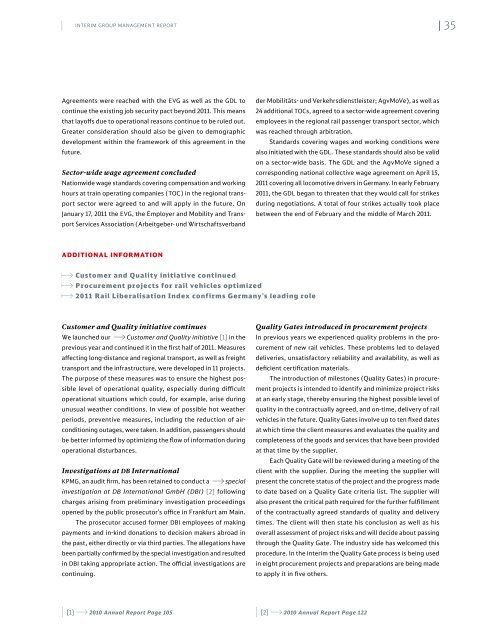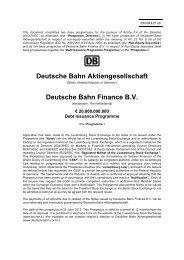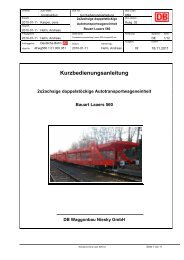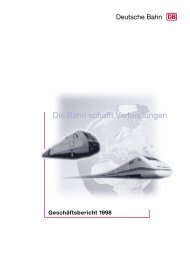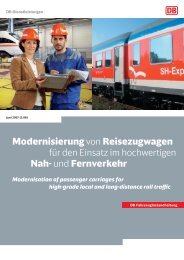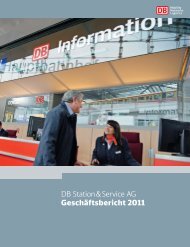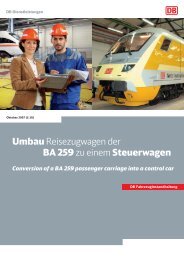PDF Download - Deutsche Bahn AG
PDF Download - Deutsche Bahn AG
PDF Download - Deutsche Bahn AG
- No tags were found...
You also want an ePaper? Increase the reach of your titles
YUMPU automatically turns print PDFs into web optimized ePapers that Google loves.
| | Interim Group Management Report35Agreements were reached with the EVG as well as the GDL tocontinue the existing job security pact beyond 2011. This meansthat layoffs due to operational reasons continue to be ruled out.Greater consideration should also be given to demographicdevelopment within the framework of this agreement in thefuture.Sector-wide wage agreement concludedNationwide wage standards covering compensation and workinghours at train operating companies (TOC) in the regional transportsector were agreed to and will apply in the future. OnJanuary 17, 2011 the EVG, the Employer and Mobility and TransportServices Association (Arbeitgeber- und Wirtschaftsverbandder Mobilitäts- und Verkehrsdienstleister; AgvMoVe), as well as24 additional TOCs, agreed to a sector-wide agreement coveringemployees in the regional rail passenger transport sector, whichwas reached through arbitration.Standards covering wages and working conditions werealso initiated with the GDL. These standards should also be validon a sector-wide basis. The GDL and the AgvMoVe signed acorresponding national collective wage agreement on April 15,2011 covering all locomotive drivers in Germany. In early February2011, the GDL began to threaten that they would call for strikesduring negotiations. A total of four strikes actually took placebetween the end of February and the middle of March 2011.ADDITIONAL INFORMATIONaaCustomer and Quality initiative continuedaaa Procurement projects for rail vehicles optimizeda 2011 Rail Liberalisation Index confirms Germany’s leading roleCustomer and Quality initiative continuesWe launched our A Customer and Quality initiative [1] in theprevious year and continued it in the first half of 2011. Measuresaffecting long-distance and regional transport, as well as freighttransport and the infrastructure, were developed in 11 projects.The purpose of these measures was to ensure the highest possiblelevel of operational quality, especially during difficultoperational situations which could, for example, arise duringunusual weather conditions. In view of possible hot weatherperiods, preventive measures, including the reduction of airconditioningoutages, were taken. In addition, passengers shouldbe better informed by optimizing the flow of information duringoperational disturbances.Investigations at DB InternationalKPMG, an audit firm, has been retained to conduct a A specialinvestigation at DB International GmbH (DBI) [2] followingcharges arising from preliminary investigation proceedingsopened by the public prosecutor’s office in Frankfurt am Main.The prosecutor accused former DBI employees of makingpayments and in-kind donations to decision makers abroad inthe past, either directly or via third parties. The allegations havebeen partially confirmed by the special investigation and resultedin DBI taking appropriate action. The official investigations arecontinuing.Quality Gates introduced in procurement projectsIn previous years we experienced quality problems in the procurementof new rail vehicles. These problems led to delayeddeliveries, unsatisfactory reliability and availability, as well asdeficient certification materials.The introduction of milestones (Quality Gates) in procurementprojects is intended to identify and minimize project risksat an early stage, thereby ensuring the highest possible level ofquality in the contractually agreed, and on-time, delivery of railvehicles in the future. Quality Gates involve up to ten fixed datesat which time the client measures and evaluates the quality andcompleteness of the goods and services that have been providedat that time by the supplier.Each Quality Gate will be reviewed during a meeting of theclient with the supplier. During the meeting the supplier willpresent the concrete status of the project and the progress madeto date based on a Quality Gate criteria list. The supplier willalso present the critical path required for the further fulfillmentof the contractually agreed standards of quality and deliverytimes. The client will then state his conclusion as well as hisoverall assessment of project risks and will decide about passingthrough the Quality Gate. The industry side has welcomed thisprocedure. In the interim the Quality Gate process is being usedin eight procurement projects and preparations are being madeto apply it in five others.| | [1] A 2010 Annual Report Page 105 | | [2] A 2010 Annual Report Page 122


